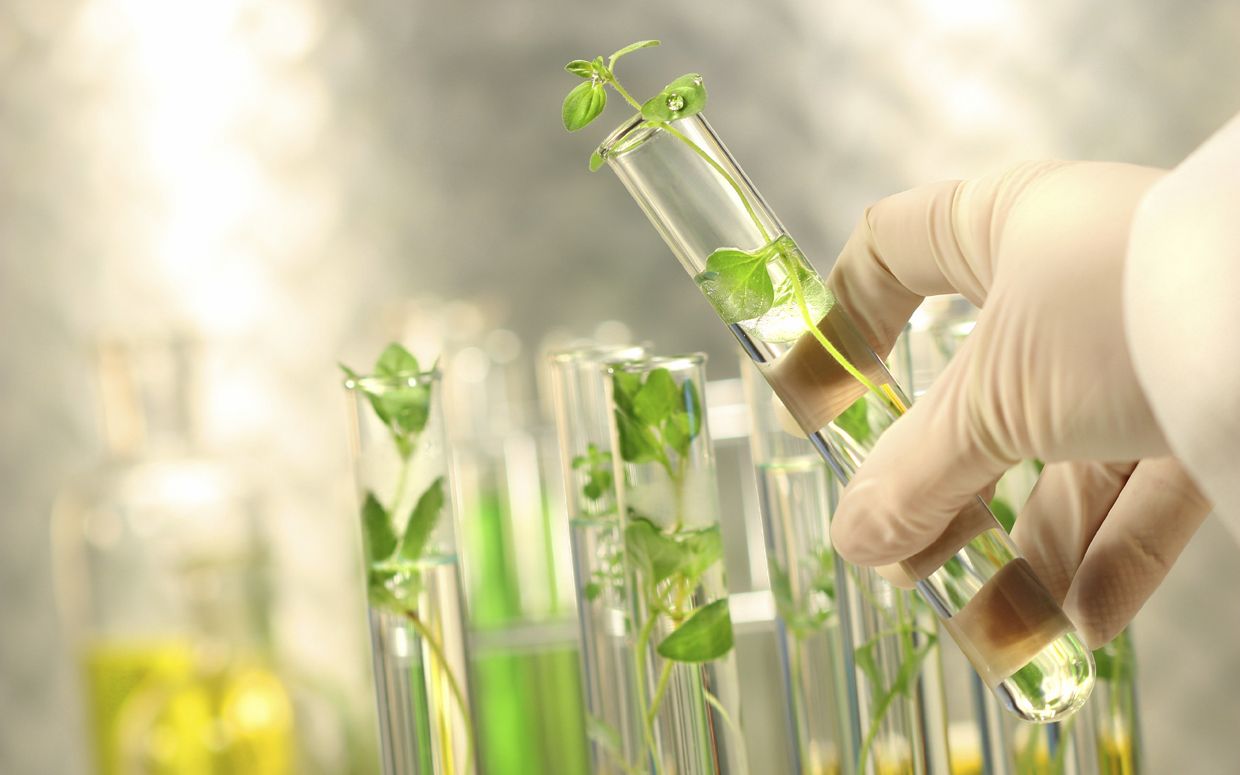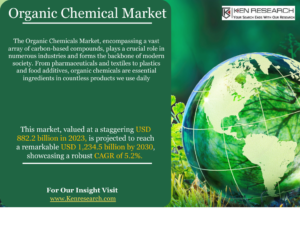
The Organic Chemicals Market, encompassing a vast array of carbon-based compounds, plays a crucial role in numerous industries and forms the backbone of modern society. From pharmaceuticals and textiles to plastics and food additives, organic chemicals are essential ingredients in countless products we use daily. This market, valued at a staggering USD 882.2 billion in 2023, is projected to reach a remarkable USD 1,234.5 billion by 2030, showcasing a robust CAGR of 5.2%. This blog delves into the intricate world of organic chemicals, exploring its key players, growth drivers, challenges, and future outlook, providing a comprehensive understanding of this vital and dynamic sector.
Current Landscape of the Organic Chemicals Market
 Organic Chemicals Market Report[/caption]
Organic Chemicals Market Report[/caption]
Market Size and Revenue
The Organic Chemicals Market size is substantial and constantly expanding, the global market was valued at USD 882.2 billion in 2023 and is projected to reach a staggering USD 1,234.5 billion by 2030, exhibiting a robust CAGR of 5.2%. This growth is driven by factors like:
- Rising Demand: Increasing population, urbanization, and industrial development fuel the demand for organic chemicals across various sectors.
- Technological Advancements: Continuous innovations in chemical synthesis and processing methods enhance production efficiency and product quality.
- Globalization: Expanding trade networks and international collaborations facilitate the global reach of organic chemicals.
Major Players in the Industry
The Organic Chemicals Market is a dynamic landscape with established industry leaders and emerging players vying for market share. Some of the Major Players include:
- BASF SE: A leading German chemical company with a diverse portfolio of organic chemicals for various industries.
- Dow Chemical Company: A renowned American manufacturer of plastics, chemicals, and industrial intermediates.
- LyondellBasell Industries: A global leader in polyolefins, elastomers, and advanced materials derived from organic chemicals.
- Exxon Mobil Corporation: A major integrated oil and gas company with a significant presence in the organic chemicals sector.
- SABIC: A Saudi Arabian petrochemical giant producing a wide range of organic chemicals for diverse applications.
Market Analysis and Growth Rate
Market analysis reveals key trends shaping the Organic Chemicals Market Growth Rate:
- Focus on Sustainability:
- Growing environmental concerns are driving the development and adoption of bio-based and biodegradable organic chemicals.
- The global bio-based chemicals market is projected to reach USD 54.16 billion by 2027, growing at a CAGR of 9.2%, indicating significant market potential.
- Consumers are increasingly seeking eco-friendly products, creating a demand for sustainable alternatives in the organic chemicals industry.
- Regional Expansion:
- Emerging economies in Asia Pacific and Latin America present significant growth potential for the organic chemicals market.
- Asia Pacific is expected to be the fastest-growing regional market, with a projected CAGR of 6.2% until 2030, driven by rapid industrialization and rising disposable incomes.
- Latin America is also expected to witness significant growth due to its expanding middle class and increasing investments in infrastructure development.
Explore More: The Future Forecast and Trends of Organic Chemicals Market with Key Player
Market Segmentation: A Deeper Dive
 organic chemical manufacturing[/caption]
organic chemical manufacturing[/caption]
The Organic Chemicals Industry is segmented based on various factors, allowing for a more granular understanding of market dynamics and growth potential. Here’s a deeper look at each segmentation:
- Product Type Segmentation:
- Aliphatic Chemicals: These are characterized by straight-chain carbon structures and include alkanes, alkenes, and alkynes. They are widely used in plastics, solvents, detergents, and lubricants.
- Aromatic Chemicals: These possess cyclic structures with benzene rings, and include benzene, toluene, xylene, and phenol. They are crucial for pharmaceuticals, dyes, explosives, and polymers.
- Heterocyclic Chemicals: These have ring structures containing atoms other than carbon, such as nitrogen, oxygen, or sulfur. They are essential for pharmaceuticals, agrochemicals, and specialty chemicals.
- Natural Organic Chemicals: These are derived from renewable resources like plants and animals, including essential oils, biopolymers, and organic acids. They are gaining traction due to their sustainability benefits.
- Application Segmentation:
- Pharmaceuticals: Organic chemicals serve as active ingredients, excipients, and intermediates in drug manufacturing.
- Plastics: Organic chemicals form the backbone of plastic resins, fibers, and films used in diverse applications.
- Textiles: Organic chemicals are used in dyes, finishes, and synthetic fibers for clothing and industrial textiles.
- Food and Beverage: Organic chemicals serve as preservatives, flavorings, additives, and processing aids.
- Agriculture: Organic chemicals are used in fertilizers, pesticides, herbicides, and animal feed additives.
- Personal Care: Organic chemicals are utilized in soaps, shampoos, cosmetics, fragrances, and hygiene products.
- Regional Segmentation:
- North America: A mature market with established players and high per capita consumption of organic chemicals.
- Europe: A major producer and consumer of organic chemicals, with stringent environmental regulations.
- Asia Pacific: The fastest-growing region due to rapid economic development and rising disposable incomes.
- Latin America: A promising market with growing industrialization and increasing demand for organic chemicals.
- Middle East & Africa: A region with significant oil and gas reserves, offering potential for organic chemical production.
Conclusion
The Organic Chemicals Market is a vital and dynamic sector with immense growth potential. Driven by rising demand, technological advancements, and strategic initiatives, the market is expected to witness significant expansion in the coming years. However, navigating regulatory constraints, environmental concerns, and intense competition will be crucial for industry players to thrive.
Read More: Organic Chemicals Market: Trends, Forecasts & Top Players in 2024







